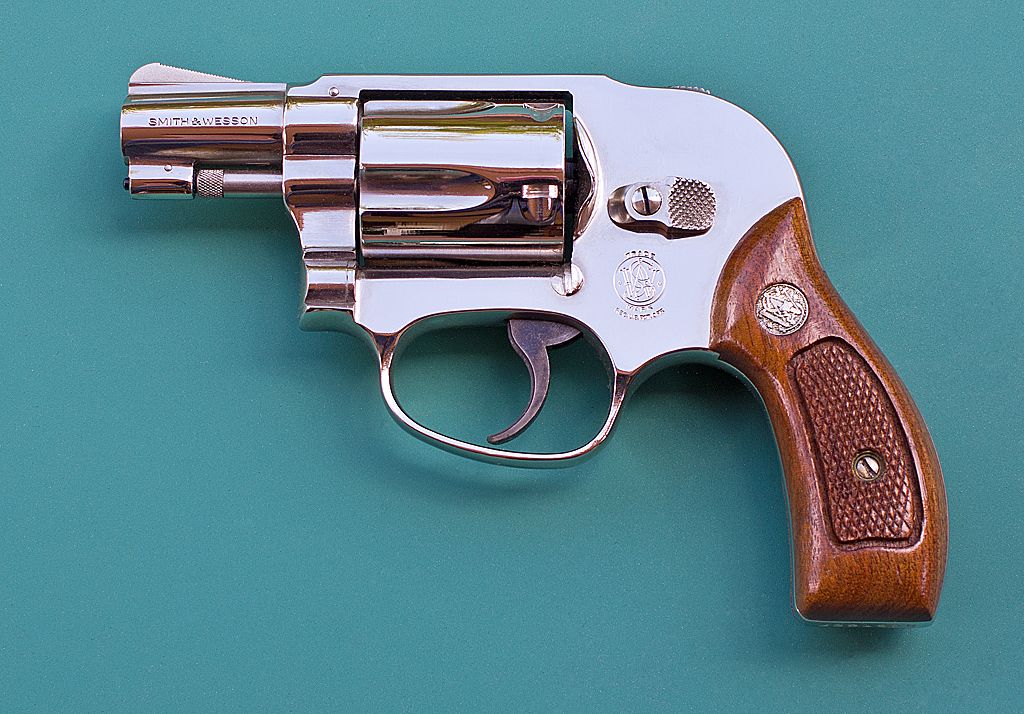This is another draft article, posted here for always-welcome comments/corrections.
John

Picture copyrighted 2015 - JLM
In 1952, Smith & Wesson introduced their .38 special 5-shot snubby Centennial revolver, which was a “hammerless” type designed to be snag-free when drawn from under clothing. It was equipped with a grip safety and was double-action only. The Centennials served their purpose of close-range self defense quite well and became quite popular in the law enforcement community. There was only one thing lacking with these diminutive guns. They lacked the ability to be thumb-cocked for a light and crisp single-action trigger pull. This would be an advantage when the intended target might be located farther away than belly-to-belly. Although some people are quite skilled in hitting targets at some distance in double-action mode, the long, heavy trigger pull of the Centennials put most users at a disadvantage for precision work at a distance. Colt’s competitive Detective Special exposed-hammer snubby revolver offered the option of an attachable hammer shroud. This revealed only the tip of the hammer for thumb-cocking, yet allowed snag-free drawing. It was an advantage that the S&W Centennial revolvers could not provide.
S&W met this demand for a snag-free small revolver that could be fired in either double- or single-action mode by designing a new model. It was based on the same small frame size as its Chiefs Special and Centennial guns (the “J-frame” in factory parlance). However this new model had an upward-extending “humpback” frame incorporating an integral hammer shroud. The exposed hammer spur tip was a different configuration than that on the Chiefs Special, with a lower profile and being slightly wider for easier cocking. Like the previous belly guns, this one also had the rounded butt and magna-style stocks that matched the butt contour.
Seeking a leg up on the shroud-equipped Colt Detective Special, S&W decided to introduce its new 5-shot .38 special revolver with an aluminum frame and steel cylinder, giving it a noticeable weight advantage. The lighter weight of the gun made it better suited for possible backup pocket carry by law enforcement. Inasmuch as pressing a grip safety while cocking the gun might cost some precious employment time in re-adjusting the user’s grip, the squeeze-safety of the Centennial was eliminated. The new gun was to be called the Bodyguard.
Smith & Wesson produced the first Bodyguards on August 15, 1955. The initial serial number was 66,000, numbered in the J-frame series. In the first year of production, 2,422 of these revolvers were produced. These early guns had four-screw side plates, flat-style cylinder release thumbpieces and pinned barrels. The upper side plate screw was phased out that same year in favor of a dovetailed tab at top of the sideplate. In 1957, when all of S&W’s handguns were assigned model numbers, the lightweight Bodyguard was officially designated as the Model 38. It began to have its model number stamped in the crane recess. The flat cylinder release thumbpiece was changed to a standard concave design in 1966, and in 1968, the central diamond surrounding the stock screw in the wooden stocks in both models was eliminated. Barrel pinning ceased in 1982.
In 1959, responding to a request from the Massachusetts State Police, S&W decided to produce a steel frame Bodyguard, making it a more rugged version for extensive use. This new gun was given the model number 49, and its serial series began with number 163,051 in the J-frame lineup. The Model 49 underwent engineering changes identical to those of the Model 38 over the years.
Both the Model 38 and the Model 49 were made on occasion with a two-tone finish; a blued frame and a stainless steel cylinder. In 1993, the finish options on both models were changed to matte blue and satin nickel. The nickel option for the Model 38 was dropped in 1996, and the cylinder release thumbpiece was changed to a teardrop pattern on all models. With a changeover to the J-magnum frame in 1997, the Model 38 guns were specifically rated for +P extra power .38 special loads. The Model 49 was discontinued in 1997 in favor of the Model 649, while the Model 38 continued in the line until January of 1999. The eventual successor to the Model 38, the Model 638 Bodyguard Airweight Stainless, made its first appearance in 1989. Only about 1200 were manufactured. This gun was re-introduced in 1996 with the J-magnum frame, rated for +P ammo. The 638-3 is still in production.
Model 649 Stainless Bodyguards in .38 special were discontinued in 1999, as the 649-3 in .357 magnum chambering (which began in 1996) became the new standard. An ejector rod shroud made its appearance. The 649-5 saw the introduction of an internal key lock system in 2001, identified by (in my opinion) an unsightly and unnecessary politically correct black hole in the left of the frame over the cylinder release thumbpiece. A small run of 649s in .38 special only was produced in 2003 as the Model 649-6. These also had the internal lock.
The Bodyguard revolvers continue today in the modern iterations of the Models 649 and 638. The utility of a smooth-drawing and snag-free double action belly gun that can be thumb-cocked for precision single action fire is still valid. Some people have opined that the open channel for the hammer on these guns could collect lint and debris that might foul the action. In actual practice, this has seldom been the case, particularly with routine cleaning. While the early Bodyguards have become collector pieces, all can still find employment as effective and reliable self-defense revolvers. They continue to be great guns, popular, and definitely classic.
(c)2015 JLM
